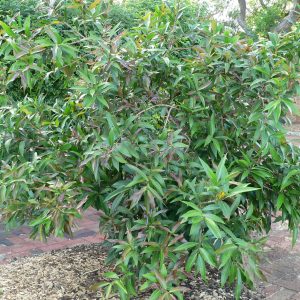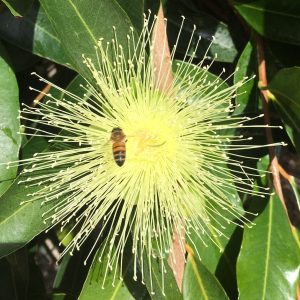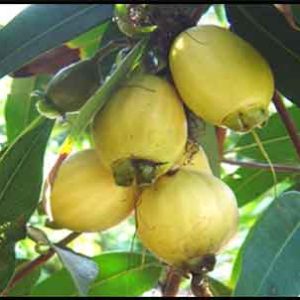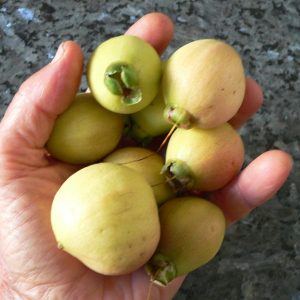Syzygium jambos
Rose apple, Malabar plum
Origin
The native range of this tropical species was the Malay Archipelago and upper Burma but it is now pantropical and also found in many sub-tropical areas. It was probably cultivated in India as early as 500 BC.
Climate
Rose apple requires a warm humid habitat, growing more profusely with rainfall above 1700mm pa. Fairly even distribution of rain is best but it will survive dry periods if soil remains moist. In tropical regions, it is found up to 1800m elevation. In cooler areas it may still grow, but produce little or no fruit. There is light frost tolerance. In several areas and countries worldwide that have climates more tropical than ours in the south west of WA, it grows so well that it has been declared a threat to other species.
Plant Description
An evergreen tree up to 8m tall and often of greater width, with a grey-brown trunk and a dense canopy. The leaves are leathery and dark green when mature, opposite and lanceolate, 8-26cm X 2-4cm. Plants develop deep taproots, but as they mature, the lateral roots become more important.
Relatives
Myrtaceae Family. The genus has 1200-1500 species, many of which are grown for their fruit. There are five commercially important species worldwide including rose apple, and these are: Java plum (Syzygium cumini), water apple (Syzygium aqueum), mountain apple (Syzygium malaccense) and wax apple (Syzygium javanicum). The number of different common names given to individual fruits leads to much confusion. Also they can be given names such as ‘apples’, ‘plums’ and ‘cherries’ which are at odds with their botanical characteristics.
Soils
Provided it has sufficient moisture, it is not overly demanding of soil requirements, but will only grow slowly if infertile, and not produce fruit in dry sands. Relatively poor drainage is not critical, nor is pH down to 5.
Propagation
Seeds are the most common means of propagation. They are recalcitrant and polyembryonic, with 1-4 embryos, giving multiple seedlings. Germination is best with fresh seeds placed on the surface of moist, shaded soil. Seedling growth is slow, subject to transplant shock, and the quality of fruit varies greatly between trees. Cuttings and air-layering can also be used.
Cultivars
There are no named cultivars.
Flowering and Pollination
Inflorescences are usually terminal corymbs, 5-10cm long, with 4-10 flowers. The showy, fragrant, bisexual flowers are white, 4-8cm wide with an inferior ovary and 2-3.5cm style. Visually, they are dominated by about 300 stamens 1.52.8cm long with creamy-white filaments. A brief dry period may be necessary to promote flowering. Pollination is by bees and other insects that are strongly attracted to the plentiful nectar.
Cultivation
With appropriate moisture and temperatures they are usually grown without extensive cultivation effort. Seedlings need shade, but mature trees fruit best in full sun. Any fertilization should be delayed till after inflorescences have formed, as new vegetative flushes will compete with flowering for nutrients.
Wind Tolerance
Good resistance and can be used as windbreaks.
Pruning
Rose apple grows naturally with a balanced canopy so pruning can be minimal after ensuring a suitable branching framework has been established. They can be coppiced quite hard and will quickly recover with multiple shoots.
The Fruit
An ovoid drupe with a persistent 4-lobed apical calyx, whitish-yellow or flushed with pink when ripe, 2-4cm in diameter. The firm dry flesh is creamy-yellow and rose-scented, containing 1-4 loose brown seeds. Nutritive value is low, with the main features being low calorie value, reasonable calcium and iron and about 14% sugars.
Fruit Production and Harvesting
Vegetatively propagated plants may crop within 4 years. Fruits ripen 4 months after flowering, but yield can be low if moisture and sunlight is not optimal.
Fruit Uses
They are eaten fresh or processed as jams and jellies, as they have high levels of pectin for favourable setting qualities. They can be brandied.
Pests and Diseases
Minimal, but rusts can be a problem. Disease load in our dry environment is low.
Comments
They are often planted for their ornamental value alone, particularly when flowering. But if you also enjoy the fruit you could eat bucket loads without having to worry about the waistline!



